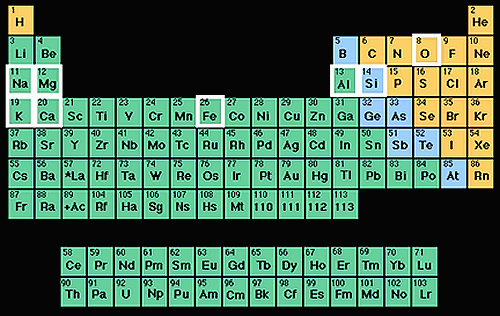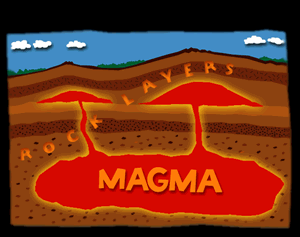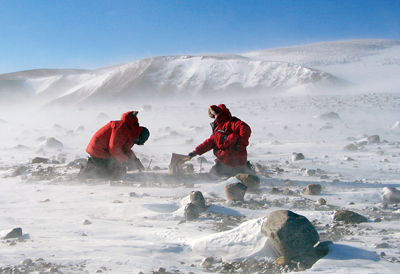John Goodge and a colleague collecting rock specimens in the Transantarctic Mountains.
Click on image for full size
Credit: John Goodge / University of Minnesota-Duluth
Newly-Found Rock May Prove Antarctica and North America Were Connected
News story originally written on July 17, 2008
Newly Found Rock May Prove Antarctica and North America Were Connected
There are lots of rocks in Antarctica. But the one that scientists just found is very special. It shows that Antarctica and North America may have been connected hundreds of millions of years ago.
The rock, made of granite, was found on a glacier in Antarctica by a team of scientists. To figure out what the rock was made of, the scientists tested its chemistry. They found that it is made of the same chemicals as igneous rocks in the southwestern United States. Those rocks used to be part of a supercontinent called Rodinia 600 to 800 million years ago. This supports the hypothesis that part of the Rodinia broke away from the southwestern United States and drifted south to become eastern Antarctica and Australia.
Figuring out where continents where hundreds of millions of years ago is a bit like putting a jigsaw puzzle together. The pieces are the continents we have today, but they have been moved from where they used to be because of plate tectonics. By finding rocks on different continents that are made of the same minerals and chemicals, scientists can piece together where the continents used to be located and how were connected.
Last modified August 22, 2008 by Lisa Gardiner.
You might also be interested in:

Many forces change the surface of the Earth over time. The largest force that changes our planet's surface is movement of Earth's outer layer in a process called plate tectonics. As shown in this picture,
...more
Minerals are the building blocks of rocks. There are many different types of minerals. All of them are solid and all are made of atoms of elements. Minerals can grow even though they are not alive. Most
...more
What’s the Earth made of? Most of the Earth’s outer layer, the crust, is made up of eight types of elements. Oxygen (O) Silicon (Si) Aluminum (Al) Iron (Fe) Calcium (Ca) Sodium (Na) Potassium (K) Magnesium
...more
These types of igneous rocks are made deep underground. In fact, it is possible that below your feet, deep within the Earth there are igneous rocks being made right now! There, hot magma cools very slowly.
...more
Scientists have learned that Mount Hood, Oregon's tallest mountain, has erupted in the past due to the mixing of two different types of magma. Adam Kent, a geologist at Oregon State University, says this
...more
The Earth's mantle is a rocky, solid shell that is between the Earth's crust and the outer core. The mantle is made up of many different reservoirs that have different chemical compositions. Scientists
...more
Some faults look strong and like they wouldn’t cause an earthquake. But it turns out that they can slip and slide like weak faults causing earthquakes. Scientists have been looking at one of these faults
...more















